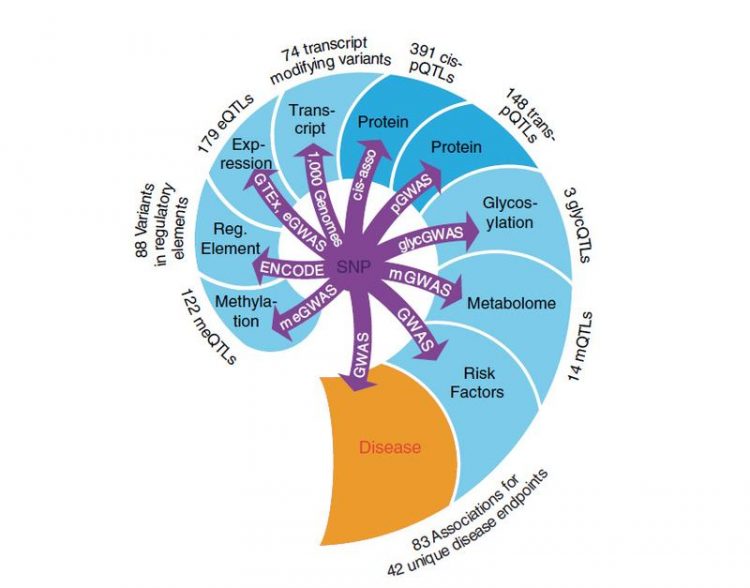Molecular patterns of complex diseases

Interaction Network of Genome, Proteome and Diseases. Source: Nature Communications / CC BY 4.0
Genome-wide association studies (GWAS) provide an opportunity to associate concentration changes in certain proteins or metabolic products with gene loci. Knowledge of these genes makes it possible to establish connections to complex diseases.
Scientists utilize the fact that to date, hundreds of associations between genetic variants and complex diseases have been demonstrated. These associations are immensely important because they do help uncover the underlying molecular mechanisms.
“In the world's largest proteomics GWAS to date, we worked with colleagues* to examine blood samples from 1,000 participants in the KORA study**,” reports Dr. Gabi Kastenmüller. She is acting director and head of the Metabolomics Group at the Institute of Bioinformatics and Systems Biology (IBIS) at the Helmholtz Zentrum München. The team quantified a total of 1,100 proteins.
Dr. Christian Gieger, head of the Molecular Epidemiology Research Unit (AME) at the Helmholtz Zentrum München, adds: “We found 539 independent associations between protein levels and genetic variants.” These overlap with genetic risk variants for 42 complex conditions, such as cardiovascular diseases and Alzheimer's disease.
“Our results provide new insights into the biological processes that are influenced by a very wide range of complex diseases and that can be used as a basis for the development of new strategies to predict and prevent these diseases,” Gieger states. The team is now planning to investigate the exact mechanisms behind the new gene-protein associations.
Further information
* Participants from the Helmholtz Zentrum München were: The Molecular Epidemiology Research Unit (AME), the Institute of Epidemiology 2 (EPI2), the Institute of Bioinformatics and Systems Biology (IBIS), and the Institute of Genetic Epidemiology (IGE). External partners were the German Center for Diabetes Research (DZD), the German Center for Cardiovascular Disease (DZHK), and Weill Cornell Medicine, Qatar and Doha, Qatar.
** KORA study: The “Kooperative Gesundheitsforschung in der Region Augsburg” (Cooperative Health Research in the Augsburg Region) study has been investigating the health of thousands of people living in the Greater Augsburg area for 30 years. The objective is to understand the effects of environmental factors, lifestyle and genes. Key topics of the KORA studies are issues involving the genesis and progress of chronic diseases, particularly cardiac infarction and diabetes mellitus. Risk factors from the area of health-related behaviour (such as smoking, nutrition, and physical activity), environmental factors (including air and noise pollution), and genetics are explored for this purpose. Issues regarding the utilization and costs of healthcare are examined from the point of view of healthcare research. http://www.helmholtz-muenchen.de/en/kora/index.html
Original publication: Karsten Suhre et al. (2017): Connecting genetic risk to disease endpoints through the human blood plasma proteome, Nature Communications, DOI: 10.1038/ncomms14357.
The Helmholtz Zentrum München, as the German Research Center for Environmental Health, pursues the objective of developing personalized medicine for the diagnosis, therapy, and prevention of widespread diseases such as diabetes mellitus and lung diseases. To this end, it investigates the interactions of genetics, environmental factors, and lifestyle. The Zentrum's headquarters is located in Neuherberg in the north of Munich. The Helmholtz Zentrum München employs around 2,300 people and is a member of the Helmholtz Association, which has 18 scientific-technical and biological-medical research centres with around 37,000 employees. http://www.helmholtz-muenchen.de/en/index.html
The Institute of Bioinformatics and Systems Biology (IBIS) concentrates on the analysis and interpretation of large, high-dimensional biological data sets in order to extract from them information on the molecular basis of complex diseases. In this framework, the institute systematically examines genetic variants, expression patterns, and protein and metabolite profiles and their associations. IBIS develops new bioinformatic and systems biology methods and resources that make it possible to model and visualize high throughput data and the results gained from them. http://www.helmholtz-muenchen.de/ibis
The Molecular Epidemiology Research Unit (AME) analyses population-based cohorts and case studies for certain diseases with the help of genomics, epigenomics, transcriptomics, proteomics, metabolomics, and functional analyses. The objective is to explain the molecular mechanisms in complex diseases such as type 2 diabetes and obesity. The unit runs the epidemiology biosample bank and handles sample administration and storage for national and international projects. http://www.helmholtz-muenchen.de/ame
Contact for the media:
Department of Communication, Helmholtz Zentrum München – German Research Center for Environmental Health, Ingolstädter Landstr. 1, 85764 Neuherberg – Tel. +49 89 3187 2238 – Fax: +49 89 3187 3324 – E-mail: presse@helmholtz-muenchen.de
Scientific Contact at Helmholtz Zentrum München:
Dr. Christian Gieger, Helmholtz Zentrum München – German Research Center for Environmental Health, Research Unit of Molecular Epidemiology, Ingolstädter Landstr. 1, 85764 Neuherberg – Tel. +49 89 3187 4106 – E-mail: christian.gieger@helmholtz-muenchen.de
Media Contact
All latest news from the category: Life Sciences and Chemistry
Articles and reports from the Life Sciences and chemistry area deal with applied and basic research into modern biology, chemistry and human medicine.
Valuable information can be found on a range of life sciences fields including bacteriology, biochemistry, bionics, bioinformatics, biophysics, biotechnology, genetics, geobotany, human biology, marine biology, microbiology, molecular biology, cellular biology, zoology, bioinorganic chemistry, microchemistry and environmental chemistry.
Newest articles

First-of-its-kind study uses remote sensing to monitor plastic debris in rivers and lakes
Remote sensing creates a cost-effective solution to monitoring plastic pollution. A first-of-its-kind study from researchers at the University of Minnesota Twin Cities shows how remote sensing can help monitor and…

Laser-based artificial neuron mimics nerve cell functions at lightning speed
With a processing speed a billion times faster than nature, chip-based laser neuron could help advance AI tasks such as pattern recognition and sequence prediction. Researchers have developed a laser-based…

Optimising the processing of plastic waste
Just one look in the yellow bin reveals a colourful jumble of different types of plastic. However, the purer and more uniform plastic waste is, the easier it is to…



